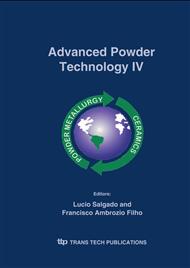p.231
p.238
p.244
p.251
p.258
p.264
p.270
p.278
p.285
Consolidation of Compacted Zircaloy Chips via Vacuum Arc Melting - Analysis of the Electric Arc
Abstract:
The main objective of this work is to present the preliminary results on the analysis of the signals arising from the electrical arc, during the vacuum arc remelting of Zircaloy electrodes, aiming the automation of the fusion process. Zircaloy electrodes were made from compacted chips resultant of the machining of Zircaloy rods. The melts were performed in a prototype (vacuum arc remelting) VAR furnace under low pressure of argon and the arc was fed by a constant DC power source. Both filtered and unfiltered signals were recorded by means of a data acquisition system. The fast Fourier transforms FFT and autocorrelation integral were used as tools for data analysis. The result showed that the events occurring within the electric arc have a strong influence on the electric signals. The analysis allowed inferring that the VAR electric arc system has mainly a chaotic behaviour and sporadic periods of linear behaviour. The conclusion of this work is that a control system may be developed, based on the modelling of the non-linear behaviour of the arc, mainly chaotic. This may allow the achievement of an automatic control for the process and yield better quality products.
Info:
Periodical:
Pages:
258-263
Citation:
Online since:
November 2005
Authors:
Price:
Сopyright:
© 2005 Trans Tech Publications Ltd. All Rights Reserved
Share:
Citation:


